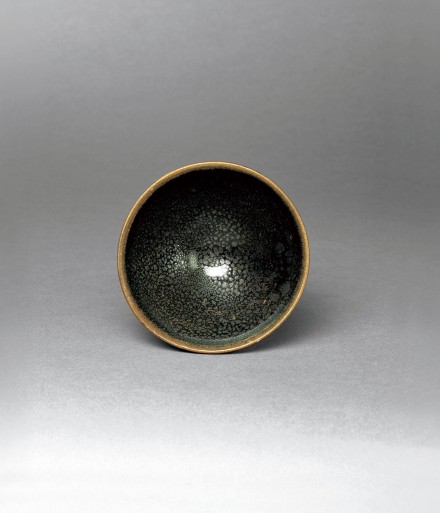J.J. Lally & Co., Oriental Art / New York City, New York
MenuPast Exhibition
Early Chinese Ceramics: An American Private Collection
March 28 - April 16, 2005

22.
A SMALL ‘OIL-SPOT’-GLAZED NORTHERN STONEWARE BOWL
Song Dynasty (A.D. 960–1279)
of almost hemispherical form, the rounded sides rising to a vertical lip, very slightly indented on the exterior and with a corresponding protrusion around the interior rim, covered inside and out with a glossy black-brown glaze thinning to russet brown at the rim and with an attractive overall pattern of iridescent silvery rust-brown ‘oil-spots’ of varying size, the glaze ending neatly well above the shallow ring foot with gently canted edge, the pale gray stoneware body covered with a black dressing.
Diameter 3 1⁄2 inches (9 cm)
Two related ‘oil-spot’ bowls of this same type from the Dane Collection, now in the Arthur M. Sackler Museum at Harvard University, which are also dressed with black slip over the unglazed lower section, were included in an exhibition at Harvard University in 1996 and illustrated by Mowry in the catalogue, Hare’s Fur, Tortoiseshell and Partridge Feathers: Chinese Brown-and Black-Glazed Ceramics, 400–1400, Cambridge, 1996, p.149, no. 43a & b, attributed to the Xiaoyu cun kilns at Huairen, Shanxi province.
Mowry, op. cit. pp. 149–151, notes that these bowls made in Northern China, with a black wash over the pale stoneware body, were “inspired by tea bowls made at the Jian kilns in Fujian province” since the dark-bodied Jian wares, made in the Southern province of Fujian, were the “most favored among connoisseurs of tea by the late Northern Song”. Mowry also provides a detailed description of the method used to achieve the ‘oil-spot’ effect by the addition of iron-rich solutions to produce iron compounds in the glaze which would crystallize on the surface during firing and thus give rise to the desired silvery ‘oil-spots’.
宋 黑釉油滴斑小碗 徑 9 厘米
22.
A SMALL ‘OIL-SPOT’-GLAZED NORTHERN STONEWARE BOWL
Song Dynasty (A.D. 960–1279)
Diameter 3 1⁄2 inches (9 cm)